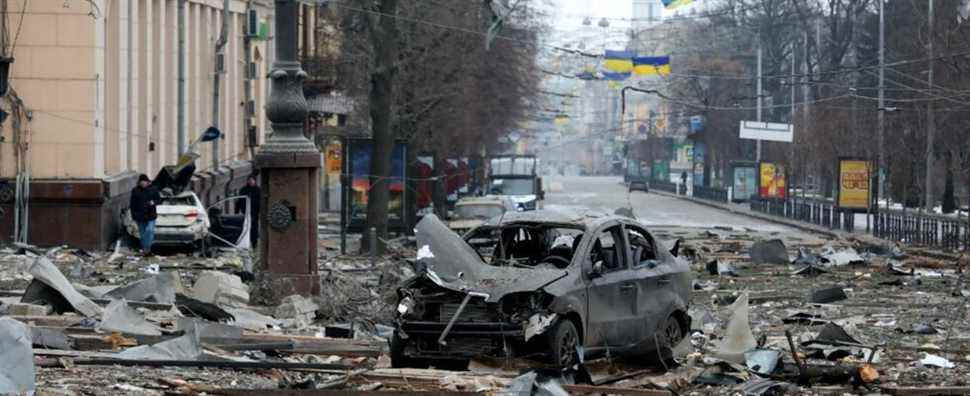After the war of weapons, that of numbers. While the two camps, Russian and Ukrainian, have accused each other of “genocide” since the beginning of the Russian invasion, the count of civilian and military victims remains very uncertain. On the one hand, official communications from Kiev and Moscow alternate between unspoken and unverifiable figures. On the other hand, international observers struggle to ensure the reliability of information on the spot, because of the fighting, and must therefore content themselves with provisional assessments communicated by the UN, which are probably underestimated.
>> Follow the latest information on the war in Ukraine in our live
On Wednesday March 2, the Ukrainian ministry in charge of emergency services reported more than 2,000 dead civilians. This is the first human toll communicated by the Ukrainian authorities since the offensive launched by Russia on February 24. Until then, the few official figures were mainly the result of individual communications, from Ukrainian political figures, like Liudmyla Denisova, Commissioner for Human Rights in the Ukrainian Parliament. The latter publishes a daily count of the number of children it presents as victims of the war, via his Telegram account. On Wednesday March 2, it reported 21 children dead and 55 children injured since the start of the invasion.
But in the absence of independent monitoring authorities, these figures cannot be verified. The UN, which strives to publish a daily report on the humanitarian situation in Ukraine, also keeps a tally of civilian casualties. The United Nations relies on the Human Rights Monitoring Mission in Ukraine (HRMMU) present in the Donbass region since 2014. Its latest reports, published on March 2, report 752 victims since February 24, including 525 injured and 227 dead. But the UN also warns that these numbers are likely to be grossly understated.
“Since February 24, our colleagues from HRMMU have been facing a very difficult situation. They are not able to visit all the locations of the incidents and therefore cannot interview victims and witnesses. their methodology, relying on other sources of information, in particular via contacts present at the places where civilian victims are recorded “explains Liz Throssel, representative of the Office of the United Nations High Commissioner for Human Rights (OHCHR), to franceinfo.
“Given these difficulties, the true number of civilian casualties is likely higher.”
Liz Throssel, Office of the United Nations High Commissioner for Human Rightsat franceinfo
The UN does not, however, list military casualties. And no non-governmental organization has yet embarked on such a census. “We do not publish this type of accounting, on the number of deaths in the armies, which can lend itself to instrumentalization in time of war”explains to franceinfo Frédéric Joli, the spokesperson for the International Committee of the Red Cross, a humanitarian institution present in the Donbass since 2014.
Consequently, the only assessments of military losses are produced by the States themselves. Kiev does not provide figures on deaths in its own ranks. But the government of President Volodymyr Zelensky does not hesitate to do so for Russian soldiers, publishing a daily report of the number of enemy soldiers killed. On Thursday March 3, the Ukrainian Ministry of Defense claimed that more than 9,000 soldiers from Vladimir Putin’s army had lost their lives since February 24.
A website was also created by the Ukrainian authorities on February 27 to allow relatives of Russian soldiers sent to the front to find out about their fate. Photos of Russian identity documents, presented as having been found on the corpses of soldiers, are included. Strategic communication, underlines researcher Anna Colin Lebedev, lecturer at the University of Nanterre. “The aim is twofold. It is on the one hand to show Ukrainians that the Russians are not crushing them and on the other hand to raise awareness among Russian families”notes this specialist in post-Soviet societies, interviewed by franceinfo.
Because Moscow has long kept silent about the losses within its army. During the first days of the invasion, very little information was broadcast by the Russian media, which were even forbidden to use the word “war”. In the communication from the Kremlin, the invasion in Ukraine is indeed described as “a special operation” and newspapers are not allowed to refer to sources other than official authorities.
It was first necessary to wait until Sunday February 27 for Moscow to recognize losses in its army, but without giving an assessment at first. And it was not until Wednesday March 2 that the first figures were released. Igor Konashenkov, the Defense Ministry spokesman, said 498 Russian soldiers lost their lives and 1,597 others were injured.
What credibility should be given to this count? “The Russian army communicates the figures it wants, because there is no control authority”, warns Anna Colin Lebedev. The researcher, co-author of a book on the fight of the mothers of soldiers for the defense of human rights within the Russian army, recalls that officially Russia had not until now recognized any military victim in Donbass since 2014. “And when material evidence was submitted to them attesting to the death of soldiers on the spot, the army replied that these soldiers were not in service at the time of the events”says Anna Colin Lebedev.
